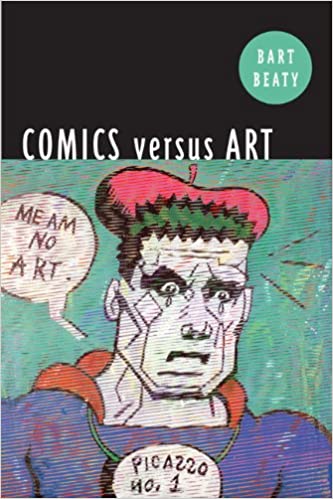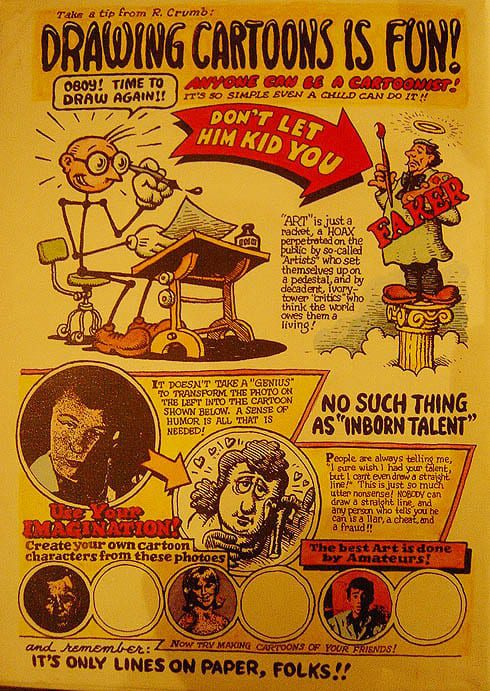Today, this is what I think about Comics.
I open with this disclaimer because it highlights one of the major difficulties with Comics Studies: a lack of clear definition. The discussion surrounding what Comics are and what Comics Studies means is such a contentious one that much of the Comics discussion has to start with it, thus eating into the larger conversation or analysis. And the outcomes are never substantial enough to be carried forward to the next project as a given. Instead, each new chapter of discourse has to start the argument again.
For example, in Bart Beaty’s book Comics Versus Art, he argues comics to be considered alongside a High Art form. Throughout his book, he highlights a problem inherent with this approach to viewing comics, in that by trying to define comics, more often than not, it removes comics from the high art discussion. It creates a contradiction. To include the history and recognizable aspects of the Comic form, you instinctively draw attention to the mass production and consumer aims of the early years of comics, which become synonymous with modern mainstream comics. This then limits your ability to hold them up against works of Art. Beaty reflects aspects of each world, the High Art World and the Comics World, and links these together in a collection of different ways. Still, he cannot convince us that the two Worlds will ever function as one without conflict or resistance if indeed they want to.
MFR ON YOUTUBE (latest video)
Help us reach 5K Subs!
This kind of thing happens across all of comics scholarship: with each new definition, the investigation’s inherent bias removes some aspect of the Comic World from the table. Coulton Waugh’s The Comics from 1947, for example, avoids all reference to aesthetics instead of focusing on form and content. Hillary Chute turns her attention to what she terms a Graphic Narrative to champion non-fiction within the Comics World, praising the form in literary terms but limiting her view of the medium*. In both examples, the writers are not dismissive of the full range of comics on offer but only reference the aspects of the Comic World that best suits their argument. They are not the only writers to do this; in fact, most writers of Comics Studies subjects will be guilty of this to a certain degree: it’s difficult not to be.

Let’s talk about Scott McCloud because it would seem that no discussion on comics can exist without his influence. McCloud is seen as one of the forerunners of Comic Studies, with his book Understanding Comics being one of the first examples of taking the medium seriously. Many articles will cite his work as such. However, there are two elements of this interpretation of his book that are problematic; firstly, it is by far not the first discussion on Comics Studies, and secondly, McCloud’s work is just as biased towards his own arguments as anyone else. Just as Waugh and Chute have to ignore or spotlight aspects of the Comic World to make their arguments, so does McCloud. He creates a definition for Comics, which allows him to include a wide breadth of visual imagery and produce a long and involved history for the art form. This gives Comics the weight of tradition and links the form to famous works of Art that are already accepted in society as High Brow or culturally relevant. The argument then becomes, if those pieces of work are accepted as High, or at least worthwhile, Art and we can link them to modern comics, then modern comics must also be worthwhile to study.
Not everyone would agree with this, including several cartoonists working within the industry. Robert Crumb was outspoken against Comics becoming part of a scholarly subject as can be seen in his 1969 comic strip ‘Drawing Cartoons is Fun’ which, as Beaty points out in chapter 3 of his book, visually attacked the idea by referring to Artists who ‘set themselves up on a pedestal’ and the dealers/promoters who are ‘pantywaist ivory-tower intellectuals.’ It becomes clear, especially when discussing comics with comics people, that there is no real desire to aim for the elitist heights of Fine Art or literature.

The importance of Comics Studies is not about the elevation of the Art form; it is about recognizing that there is an Art form there in the first place. Within Literary Studies, it is accepted that there are different degrees of the Novel. Some are seen as ‘worthwhile’ while others merely entertainment. The same is true in Film and Media Studies, and of course, fine arts like painting. There is an unspoken acceptance that some works of art will attain recognition and receive the capital ‘A’ while others will become a part of the general discourse, a way to help set the bar for excellence over the bland. The same is true of Comics, whatever definition of the form you decide on. Some comics will be printed, read, and discarded as nothing more than flights of entertaining fancy, while others will emerge out of the quagmire to be held aloft as fine examples of the medium. They will be remembered and studied for years to come, shining a light on Comics and what Comics can achieve.
Today, I believe that definitions of Comics are fed by the writer’s bias who, not from ill intent, wants to legitimize their own interpretations to champion their chosen texts. If this means focusing on a genre like Non-Fiction, or artistic process and style, then there is nothing wrong with this. As long as it is remembered that there is so much more involved, ranging from the pinnacle of Artistic achievement to the barrel scrapings of self-published propaganda. Comics are an art form unto themselves, difficult to define but easy to spot in a crowd**.
*In a later discussion in the pages of the PMLA journal, Chute defends her view of Comics and acknowledges that her essay Comics as Literature? Reading Graphic Narrative does focus on nonfiction as a point of analysis. However, she is not dismissing all other Comics or genres but instead using texts that illustrate the point she is making about Graphic Narrative and the reading as literature. I do not want to insinuate that her essay is narrow-minded because it is not, instead draw attention to it as an example of picking out of Comics what you need to prove a specific point.
**I have greatly simplified the argument in this article as the topic would require numerous studies, research, and discussions. However, as a place to start, and to make a point, a quick comparison of a few views highlights the road ahead, one that we can travel down or choose to ignore.

